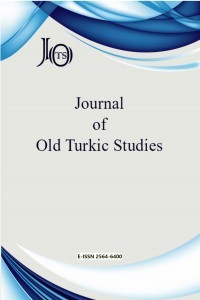Türkiye’deki Eski Uygurca Metin Neşirleri İçin Kullanılacak Harfçevrim ve Yazıçevrim Kılavuzu
Transliteration (< trans + litera) is the spelling of words from one script with characters from the another. Transcription (< trans + script) is the representation of the sound of words in a language using any set of symbols you may care to invent or borrow for the purpose. The article deals with the characters of transliteration and transcription for editing of Old Uygur texts in Turkey.
Anahtar Kelimeler:
Old Uyghur, transliteration, transcription, edition
A Manual of Transliteration and Transcription for Old Uyghur Editions in the Turkey
Transliteration (< trans + litera) is the spelling of words from one script with characters from the another. Transcription (< trans + script) is the representation of the sound of words in a language using any set of symbols you may care to invent or borrow for the purpose. The article deals with the characters of transliteration and transcription for editing of Old Uygur texts in Turkey.
Keywords:
Old Uyghur, transliteration, transcription, edition,
___
- ARAT, R. R. (1946). Türk İlmi Transkripsiyonu Kılavuzu, İstanbul: Milli Eğitim Basımevi.
- BARAT, K. (2000). Xuanzang: the Uygur-Turkic Biography of the Seventh-Century Chinese Buddhist Pilgrim; Ninth and Tenth Chapters, Bloomington: Indiana University Research Institute for Inner Asian Studies.
- CHAKRABORTTY, A. R. & B. CHAKRABORTTY (1976). “On Transcription and Transliteration”, Annals of Library and Information Studies, 23/3: 238-241.
- CLARK, L. (2017). Uygur Manichaean Texts III: Ecclesiastical Texts Texts, Translations, Commentary, Turnhout (Belgium): Brepols Publishers.
- CLAUSON, Sir G. (1962). Turkish and Mongolian Studies, London: Royal Asiatic Society of Great Britain and Ireland.
- CLAUSON, Sir G. (1972). An Etymological Dictionary of Pre-Thirteenth Century Turkish, Oxford: Oxford University Press.
- ERDAL, M. (2004). A Grammar of Old Turkic, Leiden-Boston: Brill.
- ERDAL, M. “On the frontness opposition in loanwords in Old Uygur”, Nairiku Ajia gengo no kenkyu [Studies on the Inner Asian Languages], 17: 3-23.
- FEDAKÂR, D. (1991). “Das Alttürkische in sogdischer Schrift, Textmaterial und Orthographie (Teil I)”, Ural-Altaische Jahrbücher Neue Folge, 10: 85-98.
- FEDAKÂR, D. (1994). “Das Alttürkische in sogdischer Schrift, Textmaterial und Orthographie (Teil II)”, Ural-Altaische Jahrbücher Neue Folge, 13: 133-157.
- FEDAKÂR, D. (1996). “Das Alttürkische in sogdischer Schrift, Textmaterial und Orthographie (Teil III)”, Ural-Altaische Jahrbücher Neue Folge, 14: 187-205.
- GABAIN, A. von (1959). “Eski Türkçenin Yazı Dili”, Çev. S. PAYLI, Türk Dili Araştırmaları Yıllığı Belleten 1959: 311-329.
- GARFIELD, E. (1974-1976). “Transliteration, Transcription, Translation”, Essays of an Information Scientist, 2: 254-256.
- HAMİLTON, J. R. (1971). Manuscrits ouïgours de Touen-Houang, le conte bouddhique du bon et du mauvais prince en version ouïgoure: manuscrits ouïgours de Touen-Houang, Paris: Klincksieck.
- HAMİLTON, J. R. (1986). Manuscrits ouïgours du IXe-Xe siècle de Touen-Houang I-II, Paris: Peeters.
- KARA, G. (1996). “Aramic Scripts for Alataic Languages”, The World’s Writing Systems, Eds. P. T. DANIELS & W. BRIGHT, Oxford University Press, New York-Oxford: 536-558.
- LAUT, J. P. (1986). Der frühe türkische Buddhismus und seine literarischen Denkmäler, Wiesbaden: Harrassowitz Verlag.
- MORİYASU, T. (1991). Uiguru manikyoshi no kenkyu [A Study on the History of Uygur Manichaeism], Saka daigaku bungakubu kiyo [Memoirs of the Faculty of Letters Osaka University], 31/32: 1-248.
- MORİYASU, T.(2019). Corpus of the Old Uighur Letters from the Eastern Silk Road, BTT 46, Turnhout (Belgium): Brepols Publishers.
- NAKAMURA, K. (2006). “Uigunibun ‘seizu temuni sokui kinen butten’ shuppan no rekishi haikei - U 4668 (T II S 63), *U 9192 (T III M 182) no bunseki o tsujite” [Historical Backgrounds of the Publication of Uigur Buddhist Texts Cornmemorating Temür Qayan’s Enthronement: Re-examination of the Colophons Found in U 4668 (T II S 63) and *U 9192 (T III M 182)], Nairiku Ajia gengo no kenkyu [Studies on the Inner Asian Langu-ages], 21: 49-91.
- RÖHRBORN, K. (1988). “Zur Darstellung der Gutturale in den indischen Fremdwörtern des Uigurischen”, Central Asiatic Journal, 32/4: 232-243.
- RÖHRBORN, K. (2010). Uigurisches Wörterbuch, Sprachmaterial der vorislamischen türkischen Texte aus Zentralasien, Neubearbeitung, I: Verben, Band 1: ab- äzüglä-, Stuttgart: Franz Steiner Verlag.
- RÖHRBORN, K. (2012). “Uygur Filolojisinde Üç Yayım Metodu”, Modern Türklük Araştırmaları Dergisi, 9/3: 7-24.
- RÖHRBORN, K. (2016). “Turkologie, Iranistik und das Uigurische Wörterbuch”, eine hundertblättrige Tulpe: Bir ṣadbarg lāla, Festgabe für Claus SCHÖNIG, Ed. I. HAUENSCHILD et al., Klaus Schwarz Verlag, Berlin: 389-396.
- RÖHRBORN, K. (2018). “Die Umschrift des Uigurischen: die Berliner Schulen und das uigurische Wörterbuch”, Language, Society, and Religion in the World of the Turks, Festschrift for Larry CLARK at Seventy-Five, Ed. Z. GULÁCSİ, Brepols Publishers, Turnhout (Belgium): 99-115.
- SIMS-WILLIAMS, N. (1981). “The Sogdian Sound-System and the Origins of the Uyghur Script”, Journal Asiatique, 269: 347-360.
- TEZCAN, S. (1984). “Uygur Alfabesi”, Türk Ansiklopedisi, C. 33, Milli Eğitim Basımevi, Ankara: 121-126.
- TUNA, O. N. (1960). “Köktürk Yazılı Belgelerinde ve Uygurcada Uzun Vokaller”, Türk Dili Araştırmaları Yıllığı Belleten 1960: 213-282.
- UÇAR, E. (2018). “«Etik, Eleştiri Anlayışımız ve Altun Yaruk Sekizinci Kitap Üzerine» Başlıklı Yazıya Cevap”, Journal of Old Turkic Studies, 2/2: 98-143.
- Yayın Aralığı: Yılda 2 Sayı
- Başlangıç: 2017
- Yayıncı: Erdem UÇAR
